
| Previoust |
Next |
Kia Orana (hello) from the Cook Islands!
Here's a poem Tim wrote to put you in our mood:
"Rainy Day in Paradise"
Waves still crash
Roosters crow
Palms sway in the wind
Sand clings to our feet
Tropical smells float in the air
Hammocks beckon us back
But the sun is missing
And the lagoon does not sparkle
That wonderful aquamarine blue
It's a rainy day in Paradise

It has been over a week since we left French Polynesia for the Cook Islands and it has rained every day. Some days have been completely overcast and windy all day with hard (but warm) intermittent rain. On other days, the sun will break through for a few minutes just long enough for Tim to get some pictures (this is what our friend Rick Hamill calls a "sucker hole"). The Cook Islanders are wearing jackets and sweatshirts (a rarity) as the temperature is in the low 70s. The tourists (mostly from New Zealand) are whining that this is not the tropical weather they paid for. I know that there will be very little sympathy for us, and that's okay. The weather hasn't really stopped us. First, some Q & A about the Cook Islands:
Q: Where are the Cook Islands (CI) located? What makes up the CI?
A: The CI are about 4,500 miles south of Hawaii. They are a group of 15 islands and atolls, with a total land mass of about 93 square miles. However, these islands are spread out over 707,000 square miles of ocean. The northernmost island, Penrhyn, is 600 miles away from the southernmost, Mangia.
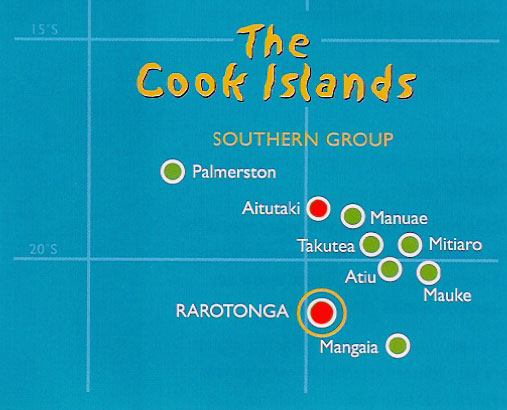
Q: What about its politics, economy, and language?
A: The country of CI is a self-governing state associated with New Zealand and the British Commonwealth. It uses New Zealand money ($1 NZ = $.66 US) and imports many NZ products (resulting in a major trade imbalance). More Cook Islanders live in NZ than in the Cook Islands. CI, unfortunately, has a long history of its politicians misappropriating money and other political shenanigans. One leader was removed (by the Queen) after he used government money to fly in voters from NZ. At one point, 60% of all jobs were government related. So now, the county has a huge national debt and is cultivating pearls and tourism to help. The people (who just had a national election) just think of it all as politics as usual and go on with their lives.
English is the official language. The native language is Rarotongan, which is related to the Maori language of native New Zealanders. All children learn English from the age of eight and they speak it with a New Zealand accent. Actually, we speak English with an American accent, so they know where we are from as soon as we open our mouths.
Q: Which of the Cook Islands did you visit?
A: The only way into the CI by plane is into Rarotonga, a volcanic island 19 miles around. It contains the capitol city, Avarua, and the CI Parliament Building (which looks like a small church hall). We spent two days here, at first, and then flew off to Aitutaki. This atoll has one, large fishhook shaped island and many little islets (motus), to form a ring. The television show "Survivor" was filmed in August on some of the motus. They are now filming "Castaways" (a British version) and will be filming "Robinson Crusoe" (a Dutch version) on Aitutaki motus as well. After three days in Aitutaki, we flew back to Rarotonga for a four-day visit. Like most of the Cook Islands, Rarotonga and Aitutaki are almost surrounded by shallow lagoons good for swimming and snorkeling with a coral reef separating it from the ocean waves.
Q: Where are you staying?
A: Many of the accommodations here are self-contained bungalows. The closer you are to the beach, the more expensive it is. Each bungalow is one large room divided into small kitchen, bath, and bed areas. All have an outside deck. Having an oven, closet, and/or washing machine available is rare. All the floors are completely tiled (for easy cleaning) and it is traditional to leave your shoes (flip-flops) outside the door before entering. Some have no screens (usually no bugs) and in others, you keep the mozzie (mosquito) coils constantly lit. There are some with no hot water, but we avoid those.
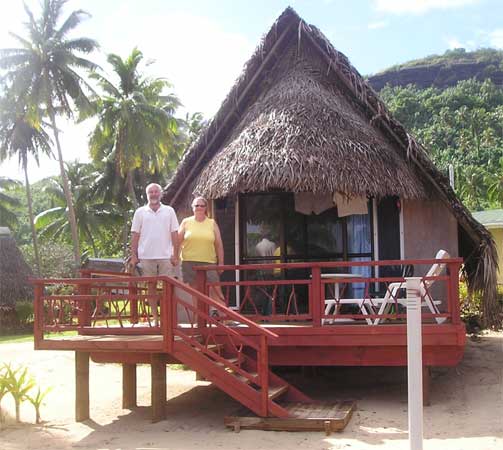
Most places have a resident gecko, like that one on the Geico commercial, or a small lizard. They come out at night and eat the bugs, hanging out on the ceiling or wall. To communicate they make a clicking sound that reminds me of someone tapping on the window. Since we don't usually have a TV and the sun sets at about 6:30 p.m., the evening entertainment is sometimes watching the geckos stalk their prey....hey, it's more fun than it sounds. The geckos really aren't a bother. I'd better check the luggage, though. Tim thinks we should have one at home! And they are certainly better than the huge spider we had in residence in Tahiti. With no snakes or poisonous animals here, a few mozzies and a gecko are nothing to fret about.
Our first bungalow in Rarotonga looked right onto the lagoon. If the sky had been clear (or even partly cloudy), we would have seen incredible sunsets. Our first bungalow in Aitutaki supposedly overlooked the lagoon, but the two large coconut trees almost completely blocked the view. After finding out the shower didn't work (management suggested we take our showers at a different bungalow) and there was no light in the kitchen (management suggested we go out to eat), we upgraded ourselves to a larger, newer place just behind the first.
In looking over options for our second stay in Rarotonga, we picked a place the guidebook suggested was "quieter" than the beachfront rooms. So here we are in a spacious, hillside place with an oven, closets, and a washing machine. It is a bit of a walk downhill to the water, but the privacy and view are wonderful.
I should mention that all housing anywhere in the South Pacific has one or more neighborhood roosters. None of these roosters can tell time. Every day (and I do mean every day), the roosters begin their serenades at about 4:30 a.m. (regardless of time zone) and continue throughout the day. This wouldn't be so bad except the sun doesn't rise until 5:30 a.m. They call back and forth to each other for hours, sounding like they are being strangled (I wish someone would).
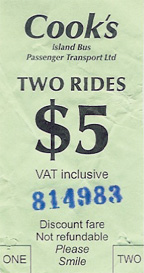
Q: Modes of transportation?
A: Aitutaki is quite small so you either pay to have someone pick you up (called a transport) and/or rent a scooter. We did both. It was good practice for Tim as we would be renting a car later in Rarotonga and New Zealand where you drive on the other side of the road. It was good practice for Di to yell, "Stay left, stay left!"
If you don't have a car or scooter, the best way around Rarotonga is the bus. For about $2 a trip, it will pick you up and drop you off almost anywhere. There are actually two buses going in circles around the island, one clockwise and one anti-clockwise (counterclockwise) - and that's how the buses are labeled. They come around once an hour so if you miss one, you just catch the next one in the opposite direction and take the scenic route home.
We've got a rented car here now and it helps us to see some of the historical sites. Also, we can pack up the snorkeling gear and chase around Rarotonga looking for the elusive sun. And we do stay on the left (most of the time).
Q: What about food?
A: Food is much less expensive here than in French Polynesia. Most of the towns have at least one market. Warning: just because a grocery store is called a supermarket doesn't mean it is large or super. In Aitutaki, the fishhook island, the main supermarket had only a slightly larger selection than our 7-11s. Here, in fact, they have the equivalent here called "6 til 11" stores, which are open 6 a.m. to 11 p.m. everyday except for church services on Sunday. Almost everything closes down by two on Saturday and all day on Sunday, so you need to do your food shopping early.
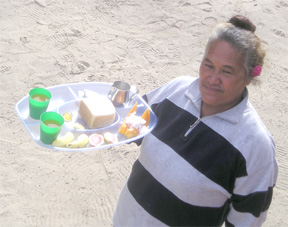
Some accommodations come with breakfast. In Aitutaki, at precisely 8:30 a.m., one of the women workers brought us a plastic tray with two tea bags and sugars, two pieces each of guava (mostly seeds) and mango, fruit juice, and four slices of white bread - this is known as a tropical breakfast. You make your own tea and toast. Not too different from the continental breakfast some of you know (just eliminate the fruit and put in a baguette).
We try to save money by cooking our own meals most of the time. Breakfast (unless included) is granola and yogurt with fruit (fresh pineapple if we're lucky). Lunch is a sandwich. Dinner is usually a combination of a soup or sauce mix, chicken or beef or beans, rice or ramen noodles, always an onion, and whatever veggies are available. Since the kitchens usually have only one or two pots, a dull knife for slicing, and a lousy can opener, we have been making do. We are not really suffering (nor losing weight). And we like to try out the local ice creams, cookies (called biscuits here), and other goodies.
There are some adjustments to make. Since the CI are on the metric system, you order meats by the kilogram. Actually, don't order a kilogram, since that is over 2 pounds....enough meat for a party! Also, since there is never a measuring cup, we use old Coke bottles to figure out how much water is 600 milliliters to make soup. After a day of walking or snorkeling, we aren't fussy.
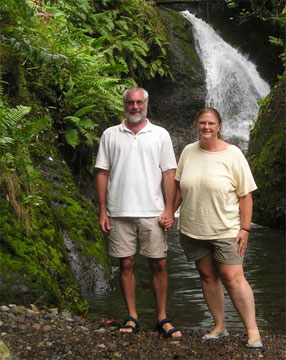
Q: So, what have you two been doing?
A: We've circled the islands to see a variety of interesting sites. On each island were very old marae, the stone platforms used for religious ceremonies several centuries ago. Rarotonga has a mountainous center, so we drive up the valley roads and have seen the family farms, a cave, the only waterfall on the island (see attached photo), and how people live outside of the town. Cook Islanders are incredibly friendly and often wave to you as you pass them. Since they know we are on a road with no outlet and we don't, we get to wave to them again sheepishly on our way out.
When we were in Aitutaki, we took a water taxi to a deserted motu called Maina and spent the day snorkeling and exploring. Di even made a basket out of coconut palm leaves, based on a demonstration she had seen earlier. It wasn't pretty or sturdy, so I think I'll stick to my day job. Of course, it was raining for part of the day but that doesn't matter when you are snorkeling.
As we walk about, we've seen lots of crabs. On the beach walks, you can see tiny walking shells that stop when you come near. They are crabs that move into vacant seashells, moving to another one when they outgrow their home. Along the roadside near the water, there are many holes in the ground ranging from the size of a quarter to a baseball. These are the homes of the coconut crabs, which live underground as their shell hardens after a molt. The crabs use their claws to open coconuts, so you don't want to poke your finger in any of the holes. I tried to open a coconut once and it took a hammer and a screwdriver...I have a lot of admiration for these creatures.
Of course, there is always souvenir shopping to do. You have to watch what you buy, even the tropical print clothing and fabric is made in China. This is the other place (besides French Polynesia), however, for black pearls. Years ago, Tim bought me a freshwater pearl necklace. I am drawn to the natural, irregular look of those white pearls. The perfect black pearl is round. So we discovered "keishi", the natural black pearl produced by the oysters that are not implanted with a "starter" seed. Keishi come in a variety of colors (gold to green to black), very convoluted in shape, and considerably less expensive than the "black pearl". We spent many rainy hours looking over hundreds of keishi.
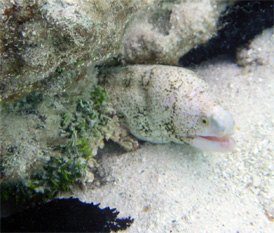
Weather Alert: The sun was spotted in the Cook Islands today so we hit the snorkel hot spots. Recent storms and warming waters have destroyed much of the coral, but we did find some areas with lots of fish. We've seen fish with tropical colors (parrotfish, triggerfish), fish with unusual shapes (puffer, boxfish, flutefish), small purple-lipped clams, big blue starfish lounging on rocks, and a mean looking white moray eel. Tim has been taking lots of photos with his underwater digital camera, so beware when he brings out the photo books!
Sadly, today is our last day in the Cook Islands. Hopefully we can get in some more snorkeling. It is a comfortable place and we would like to come back. However, we have to pay a $30 per person exit tax. That's right, you have to pay to leave the Cook Islands. (What if we don't have the money? Do we get to stay?) Tomorrow we catch the 4 a.m. flight to Auckland, New Zealand and then on to Christchurch to start our NZ tour. Due to the International Date Line, we completely miss Wednesday, October 4. Does that make us a day younger?
Take care of yourselves. Meitaki (thank you) for reading and Aere Ra (goodbye).
Di & Tim
| Page Top |
Map |
Itinerary |
Previous |
Next |
| Tim and Diane's email address is ttdk@comcast.net | ||||